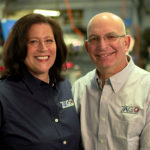
Gail Friedberg
Early in the COVID-19 pandemic, we began speaking with businesses that were deemed essential to learn what safety strategies they put into place and how they were coping overall. ZAGO Manufacturing was one of those businesses — a global manufacturer of high-tech, custom sealing solutions and components.
In this interview, ZAGO CEO, Gail Friedberg, joins us again to share how the company has been doing since then. Gail also offers some tips and advice for other manufactures that may be considering or just reopening now.
Click here to listen to our first conversation in April.
And here’s the latest interview…
The following is a lightly edited transcript…
Fastener Engineering (FE): Hello, everyone. Thanks for listening! I’m Michelle Froese, an editor with Fastener Engineering. Over the last few months, we’ve been reaching out to manufacturers and suppliers that have been deemed essential during the COVID-19 pandemic. As these companies never shut down, we’re asking what advice they may have for others in the industry that are just starting to or still considering reopening.
I recently chatted with Gail Friedberg, the CEO of ZAGO, a global manufacturer of high-tech, custom ceiling solutions and components. We also spoke with Gail back in April about how ZAGO was handling the restrictions, such as social distancing and what safety protocols the company had in place. So, we’ll also link to that interview in the notes for this conversation.
But I wanted to follow up with Gail to see how things have been going since then, and to find out what lessons she may be able to share with others in the fastening industry when it comes to managing the pandemic at work.
Here’s my conversation with Gail now…
Gail Friedberg (GF): Thank you so much for having me, Michelle! It’s my pleasure to be back.
FE: So, how have you been doing since we last spoke?
GF: We’ve been doing really well, Michelle. The policies and the practices that we instituted in March…we’ve given it time — March through April — to see what’s worked. What’s worked is what we’ve stuck with, and it’s continuing to work. We’re very productive and we haven’t had one illness since the outbreak. We had one employee very early on before anybody knew really what was going on, and they were out for a month. But we haven’t had one illness since then. I attribute it to our education of our employees and the practices that we’ve put in place.
FE: Can you please provide an update on some of those processes and procedures, Gail…or perhaps any that may have changed since March or April, given the ongoing pandemic?
GF: When we first started getting ourselves accustomed to the new normal — and when we say new normal, we’re not talking short-term. New Jersey shut down almost completely, other than essential manufacturing in the middle of March, and then didn’t really open up until the middle of June. But we’re not changing anything since the reopening. The practices we had in March…the ones that we’ve found that work are going to be with us until the pandemic is gone completely from the country, from the world.
But, it took a little time in the beginning and we had to play with schedules. We were doing every other day for different employees, having cohort A, cohort B, and that didn’t work. Then, we tried every other week, but that didn’t work. Then: half a day, with six-hour morning shifts and six-hour afternoon-to-evening shifts.
What we found that worked for us was having staggered schedules. So, now we have people start very early in the morning, which is great in the summer because it’s so hot. But, they work until the evening. We still have only one shift, but it’s a very long shift that people come in at staggered times.
FE: I see. Well, it sounds like it’s been a bit of a trial and error process. As an essential manufacturer, what advice or words of wisdom can you share with others in the industry that are just reopening now?
GF: So, the first thing is to be flexible. If it looks like something isn’t working, it’s not. Come up with new ideas, have different alternatives…keep working at it until you find something that works for your employees and works for the management of the company. But you may not hit it the first time, so keep working at it. That’s what we found, we just had to keep trying because what looks good on paper, isn’t necessarily what’s going to work out in practice.
FE: Right. I assume communication is big with your team.
GF: Yeah, constant communication is key. In the beginning, especially, we had multiple Zoom meetings because you have to continually reinforce the message and you also have to keep reassuring your employees that you’re doing the best for them…that they come first, that a healthy workforce is the most important aspect to having a healthy business. You have to, in the beginning, build a level of trust.
For example, we were only closed for two days during this whole pandemic and we closed because our employees weren’t feeling comfortable. It was very early on and you have to listen to that, to them.
So, we closed and spent two days sanitizing. Then, when we reopened, we haven’t had a problem since. We haven’t had that issue since, because our employees know … they knew before, but this is different times. They know that they can trust us to do the best thing for them.
FE: You mentioned the new normal a little bit earlier on in our conversation. We’ve spoken to a couple of other companies that have remained open during the last few months, and they say it’s critical to rethink the way business is done to remain successful…say, everything from digital meetings, like Zoom, or reaching out to new sectors for business. Can you say more about this for ZAGO?
GF: Yeah, in terms of just looking at the workforce, a year ago I never would have thought that so many of our employees could or would work from home. Even the assembly people are working from home — these are people who I never would have thought that we could make it work. We have no intention of changing it.
Employees are all allowed to come back to work and we can have them six feet apart, social distancing, but there’s really no reason to. When you have people with school-aged children, they really need to be home. So, you have to have that option for them. So, those kinds of things…just having different options for different employees. Again, being more flexible in how you look at work and your workplace is really important now.
Then, in terms of marketing, I mean, we’ve gotten really creative and we found that our customers have gotten more creative, too. So, we are doing a lot more webinars. We’ve found that our customers are craving content, they’re craving information for their people. So, we’re developing webinars for our big distributors and educating them more about our products. The whole digital video media has opened up a whole new avenue of access to our customers that no one was really thinking about before because before everything was thought of in terms of in-person meetings.
FE: Makes sense. I was just going to ask you about how you remained creative during this time. What about in terms of manufacturing…are there any new products or ideas that you have planned that you’re willing to share?
GF: We’re continually working on making our products better and being responsive to our customer needs. We don’t do the design, but we get prints from our customers.
What I can say is that as creative as our customers are, that’s also how we’ve been able to be. We’re more responsive; we have more in-house manufacturing capabilities all the time; we’re constantly buying new and updated machinery to meet our customer needs in terms of meeting just how ingenious the products are that they think of. We’re capable of manufacturing them to their specifications.
FE: Have you had any new or innovative requests? I know you do supply to the medical device industry as well.
GE: Yeah, well, we had a partnership and have an ongoing partnership with a customer, Ventec — who had a partnership with GM to make ventilators. We were one of about 100 different vendors who were part of that critical project to get the ventilators manufactured, and to get the line up and running in record time and get the ventilators manufactured.
To be very honest, I really wish we didn’t need to do that business. I really wish that the ventilators weren’t needed, but the way things are looking, they’re going to be very much critically in demand. It’s a business I could live without. But if the product needs to be made, we’re a good partner to make it with.
FE: Well, I’m sure they’re grateful you’re able to help out.
GF: Yeah.
FE: What are your thoughts about the future of fasteners? Do you remain hopeful given everything going on this year?
GF: Well, fasteners hold things together. The world still needs to be held together, so you can’t make anything without fasteners. Fasteners, especially our high-tech, self-sealing fasteners, are very much a part of the future. One of the most interesting products that have come along that our customers make, is they’re buying parts from us to make drone ports” The drones go out, and then they have to come back somewhere and get recharged, and that’s a drone port. So, our products are going into those. Products I never would have imagined we’re seeing come through the office every day, and it’s really exciting!
With everything that’s going on, it’s great to see that innovation is still happening…progress is still being made and we’re just really happy to be part of that.
FE: So interesting. You mentioned some new equipment. Have there been any changes, other than personnel and keeping socially distant, of course…but any changes in terms of your equipment?
GF: In terms of the factory, and I think I may have mentioned this in our last interview…because we moved so much to automated processes, you really don’t need to have a lot of people on the factory floor to run all of our equipment. It’s only on the factory floor that you actually have to have people there, like in person, so we’re just socially distancing by design because of all the automation that we did.
FE: That makes sense. Are there any other messages or words of advice that you’d like to share with others across the manufacturing world at this time?
GF: Just one thing, is they use the words essential manufacturing for us. We knew from the beginning we were an essential manufacturer but, I have to say, I think that all manufacturing is essential manufacturing, and I hope that all manufacturing gets back up and running. The best jobs are manufacturing jobs; it’s been that way for a long time. We built the middle class in the United States on manufacturing jobs.
So, I hope that any manufacturers who are out there who are maybe on the fence about getting started again, please get started. The pathway is there, rely on your local manufacturing extension programs for assistance. NJMEP has been fantastic. There are great resources out there, so please get open, get up and running…and welcome back!
FE: Great advice! Thanks, Gail. If listeners would like to learn more about ZAGO, where can they go?
GF: Oh, they can go to our website… www.ZAGO.com. We’d be delighted to have the visitors.
FE: I appreciate the conversation, Gail. Thanks, everyone else for listening today. I am Michelle Froese with Fastener Engineering.









Tell Us What You Think!